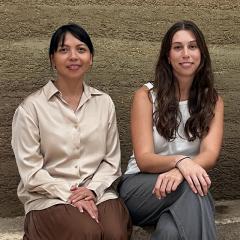How can we 3D print building components made from seagrass or algae? Could substitutes for concrete and masonry made from fast growing micro algae help to turn our buildings into carbon sinks? And how can blue biomass contribute to a circular economy of materials?
The international network “Building with Blue Biomass” establishes research collaborations between leading experts from Denmark, Australia and the UK.
The network creates a platform to connect local knowledge and share solutions between countries rich in regenerative blue biomass resources and identify future pathways and research to reduce the environmental impact of the building industry. It is led by the Royal Danish Academy – Architecture, Design, Conservation and includes 3XN/ GXN Architects, the Danish Technical University, Arup, University College London, Queensland University of Technology and University of Queensland.
Paul Nicholas, Associate professor at the Royal Danish Academy – Architecture, Design, Conservation and head of “Building with Blue BioMass” states:
“Our future building culture will be one of bio construction and bio renovation. Marine based materials and advanced manufacturing should play a key role, but we need to consolidate knowledge and translate research to speed up implementation”.
Vast opportunities for new product development
Combining architectural design with biochemical engineering, material development, advanced manufacturing and bioeconomy, the network will investigate how future building materials can be made from blue biomass. This includes organisms from the sea, lakes, streams and aquaculture facilities such as algae, kelp, shellfish and seagrass.
The network will examine how these diverse regenerative materials offer vast opportunities for new product development, particularly in the quest for bio-based building materials as well as biodegradable polymers to replace harmful synthetics in our built environment. Simultaneously, the project will draw attention to the role of blue-biomass in sustaining the world’s water bodies and marine ecosystems.
Processing the local and renewable resources into new materials and high value architectural products requires interdisciplinary research and market experience. Building with Blue Biomass brings together that leading local knowledge and is directed towards the rapid expansion of the wider architectural market for biobased materials and biopolymers.
“Building with Blue Biomass” is supported by the Danish Ministry of Higher Education and Science with one million Danish Kroner as part of its Global Innovation Network Programme and lasts for two years.
Founding partners
CITA (Centre for Information Technology and Architecture) Royal Danish Academy – Architecture, Design, Conservation (Lead); Technical University of Denmark; Queensland University of Technology; University of Queensland; University College London; Arup; 3XN/GXN.
For further information please contact
Paul Nicholas, Associate Professor, CITA, Royal Danish Academy – Architecture, Design, Conservation; paul.nicholas@kglakademi.dk, +45 41701751
Inge Henningsen, Press Officer, Royal Danish Academy – Architecture, Design, Conservation; inge.henningsen@kglakademi.dk ; + 45 417015 33
Professor Ben Hankamer, UQ Institute for Molecular Bioscience; b.hankamer@imb.uq.edu.au +61 7 334 62012
Senior Lec Fred Fialho Teixeira, UQ School of Architecture Design and Planning; F.frederico@uq.edu .au +61 405 672 772



